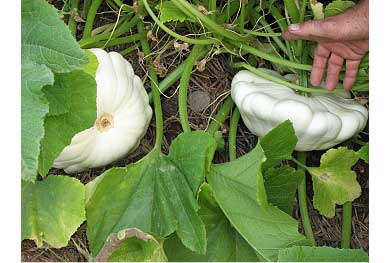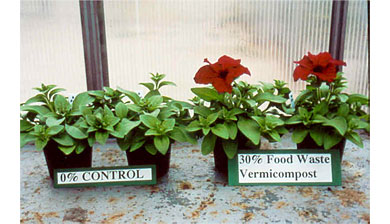| |
HISTORY OF VERMICOMPOSTING
Vermicomposting, as an industrial process, was originally developed to remove unwanted organic materials from the agricultural and industrial waste streams. The derived product: earthworm castings, is now recognized as a high value material which, when blended with soil, can restore soil tilth by correcting the imbalances caused by the over-utilization of petrol-chemical based fertilizers; thus enabling crops and plants to naturally combat pests and diseases, all resulting in increased crop production and general plant health.
Using European technology we began researching production processes and the potential of Vermicomposting over 20 years ago. In 1991 we built the first American flow through Vermicomposting processor in Portland Oregon which continues to handle more than 2,000 tons of food waste per year at an annual cost savings of approximately $70,000.00. The Worm Castings are sold as an Organic soil amendment or mixed to form valuable plant growth media, as well as providing a natural pesticide and fungicide.
In 1997: Awarded our first of three Phase I, and Phase II USDA-SBIR grants enabling advanced engineering, design and process modifications to be made in order to achieve a greater understanding of the production process and the products potential.
In collaboration with Ohio State University, and Professor Clive Edwards, these grants supported extensive field and greenhouse trials using Vermicompost on a wide range of fruits, vegetables and ornamentals. The results clearly demonstrated that the affects were nutritional - as all experimental plants received the same full range of nutrients – and remarkably small quantities of Vermicompost promoted enhanced germination, growth, flowering and yield on a variety of crop plants.
Agricultural wastes, food and garden wastes, paper waste, and bio-solids from waste water treatment plants, when processed by earthworms, all showed similar results. With the aid of two additional USDA-SBIR grants - again collaborating with OSU and Dr. C. Edwards - we investigated a range of structural and functional comparisons between Vermicompost and traditional types of compost.
- The continuous-flow production process does not allow nutrient leaching as occurs with conventional thermophilic composting and some less efficient methods of Vermicomposting
- There were large physical, chemical and biological differences, all seemingly related to leachate control and the organic waste passage through the earthworms gut.
- Vermicomposting was far more efficient in controlling odors and other vector issues.
- With high worm populations and optimum conditions Vermicomposting is much faster than most conventional composting processes.
- The percentages of Nitrogen, Potassium, Potash, Magnesium, and Calcium - in forms readily available for plant uptake - are much greater in Vermicomposts.
- Microbial activity is much greater in finished Vermicompost; maintaining many types of bacteria and fungi that contribute to soil health and fertility.

Our research showed - in laboratory, greenhouse and field trials - that a specific amount of Vermicompost, added to commercial potting mediums, suppressed diseases, insect populations and insect damage to and on plants grown in Vermicompost treated soils.
It is now widely accepted that the readily available micro organisms available in Vermicompost are the likely source of the plant growth regulators and Humates now known to be responsible for the increased germination, flowering and yields found in the plant growth trials.
The project then focused on investigating the reason why the smaller particle size and greater moisture holding capacity in Vermicompost contributed to a decrease in soil nutrient leaching when Vermicompost was added to soils; demonstrating the destruction of viable weed seeds through Vermicomposting and the destruction of humane pathogens in contaminated organic wastes during Vermicomposting. This second part of the Phase I, Phase II: Plant Pest, Disease and Human Pathogen Control results, according to the EPA 503 Regulations, achieved Class "A" material in 60 days with bacterial levels for Salmonella, Ecoli, and viable Helmath Olva were all non-detectable. We developed our operational protocols from this research, and this research and operational training goes with every system.
Other investigations concentrated on the properties of Vermicompost that increased plant growth. The increased plant growth observed greatly exceeded any of the nutrient inputs applied and all recent plant growth trials received balancing levels of nutrient inputs to ensure nutrients were not the cause.
- Small additions of Vermicompost decreased the incidence of various plant diseases and the numbers of plant parasitic nematodes were suppressed.
- Further research investigating production methods (Third part of Phase I and II) and effective practical applications of water soluble elutriates for foliar application - for immediate disease and pest control - are ongoing. Initial results were completed in June 2009 : Liquid Extracts for Disease and Pest Control.
- Heat sterilization of finished Vermicompost was shown to remove all plant growth enhancing properties, but these could be restored by the addition of aqueous extracts of un-sterilized Vermicompost. This demonstrates the key factor is clearly microbial, most likely associated with plant growth regulators and increased levels of humic acid and folic acid found in Vermicompost.
- Results showed increased growth effects were more frequent and more pronounced at specific concentration levels and application rates. When plants were grown in less specific blends - or in mixes of greater concentrations of Vermicompost - the beneficial growth, disease and pest control was greatly reduced or lost completely.
- This result was unexpected, but confirmed by detailed and rigorous studies using a wide range of Vermicompost substitutions in a commercial plant growth media and in a wide range of plant species.
- Optimum germination, growth, flowering, and heavier fields occurred only in a specific formulation that included nutrients other than what is in the Vermicompost.
- This takes us down a path that suggests that the chemical or biological agent - that is providing the disease control and triggering the plants ability to respond systemically to pest and disease issues - is either a soluble uptake or has to be manufactured by the plant as an antagonist.
- Conclusion: too much Vermicompost can block the functions that triggers these responses; similar to the way too much nitrogen locks in the leaves and does not allow the proper function of the plant.
- Lastly, vigorous, healthy plants, as were observed when grown with Vermicompost, are far less susceptible to attack by plant pests and diseases. Tolerance, resistance, suppression, or the ability to manufacture an antagonist to plant pests or diseases are sometimes difficult to distinguish, but decreases in lesions and other symptoms, and decreases in the numbers of causative organisms have been found.
|
|



